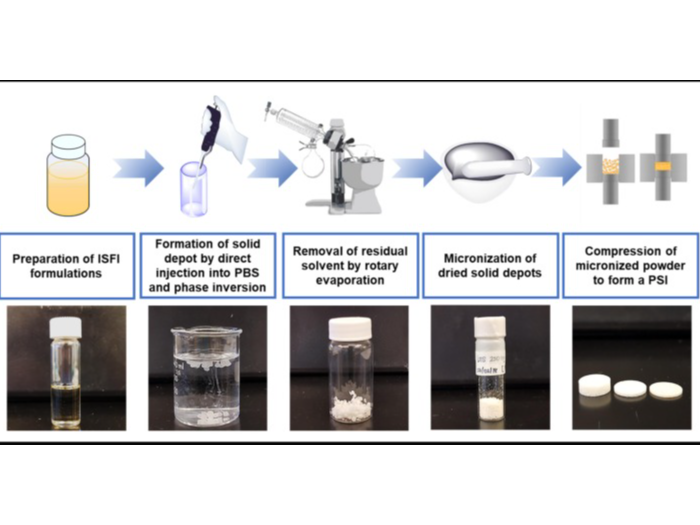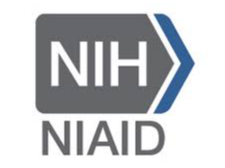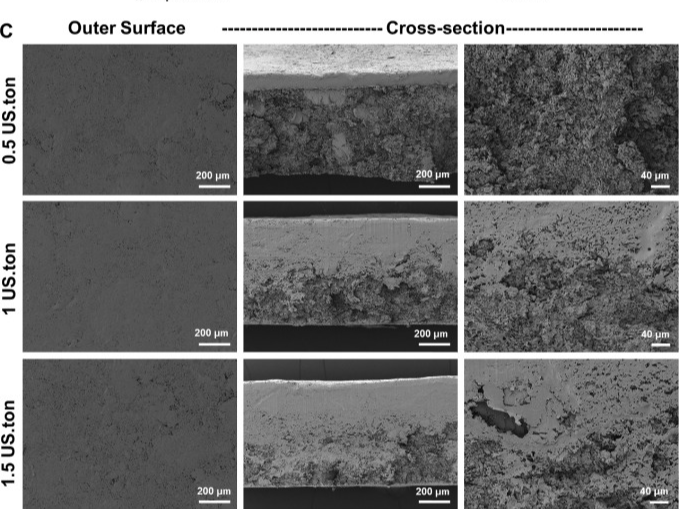
|
Developed by 

|
Supported by 

|

Tunable Biodegradable Ultra-Long-Acting Polymeric Solid Implant (PSI)
Verified by the innovator, on Apr 2022Developer(s)

|
University of North Carolina at Chapel Hill https://benhabbour.web.unc.edu/United States Our research at the Benhabbour Lab focuses on engineering novel tunable delivery platforms and polymer-based devices that can treat or prevent a disease. Our work combines the elegance of polymer chemistry with the versatility of engineering and formulation development to design and fabricate efficient and translatable delivery systems for a wide range of applications. |
Sponsor(s)

|
NIH-NIAID https://www.niaid.nih.gov/ |
|
|
UNC CFAR - |
Partnerships
|
|
- - |
Technology information
Type of technology
Polymeric implant
Administration route
Subcutaneous
Development state and regulatory approval
Dolutegravir (DTG)
Pre-clinical
None
Description
Ultra-long-acting (ULA) biodegradable polymeric solid implant (PSI) that can accommodate one or more APIs (e.g. ARVs) at translatable human doses in a single implant, in a form of single or multi-layer multi-drug PSI. Administered subcutaneously, PSIs are well tolerated in vivo and effectively delivered drug(s) over 180 days, achieving plasma concentrations above therapeutic targets. While biodegradable, these PSIs can safely be removed to terminate the treatment if required. The versatility of this technology makes it attractive as an ULA drug delivery platform for HIV and other applications.
Technology highlight
Biodegradable polymeric solid implants (PSIs) are fabricated using phase inversion of drug-loaded polymer-based solution in combination with a compression technique that allows fabrication of PSIs with high drug loading (up to 85 wt%) and compact sizes. The fabrication of these PSIs is accomplished using a simple and scalable stepwise process of (1) phase inversion of a drug-loaded polymer-based solution to form an initial in-situ forming solid implant in an aqueous medium, (2) micronization of dried drug-loaded solid implants, and (3) compression of micronized drug-loaded solid powder. The resulting PSIs are solvent-free and consist of only the biodegradable polymer and drug(s). The manufacturing process does not require high heat or high pressure and can be easily scalable.
Technology main components
Poly(DL-lactide-co-glycolide (PLGA) or other biodegradable polymers (e.g. PLA, PCL)
Information on the raw materials sourcing, availability and anticipated price
Raw materials are readily available on the market
Delivery device(s)
No delivery device
APIs compatibility profile
API desired features
Water-soluble molecules
Water-insoluble molecules
Small molecules
Dolutegravir, Rilpivirine, Cabotegravir
Nucleic acids
Confidential
Proteins
Confidential
Additional solubility data
Not provided
Additional stability data
Not provided
API loading: Maximum drug quantity to be loaded
75-90 wt%
API co-administration
2 different APIs : at least 2
LogP
Not provided
Scale-up and manufacturing prospects
Scale-up prospects
Scalability anticipated. Additional information needed.
Tentative equipment list for manufacturing
Additional information needed
Manufacturing
New fabrication process using phase inversion and compression. Does not use high heat, high pressure or large volumes of organic solvents. Additional information needed.
Specific analytical instrument required for characterization of formulation
Additional information needed
Clinical trials
Not providedExcipients
Proprietary excipients used
No proprietary excipient used
Novel excipients or existing excipients at a concentration above Inactive Ingredients Database (IID) for the specified route of administration
No novel excipient or existing excipient used
Residual solvents used
Dimethyl Sulfoxide (DMSO)
Additional features
Other features of the technology
- Biodegradable
- Drug-eluting
- Monolithic
- Removable
- Single-use
- Room temperature storage
- At least 1 year shelf life
Release properties
Slow diffusion of the drugs through degradation of the PLGA matrix by hydrolysis of ester linkages in the presence of water, with minimal initial burst.
Injectability
Additional data needed
Safety
Well tolerated in vivo (BALB/c mice) over six months. No signs of toxicity, behavioural changes, water consumption, weight loss. Histological staining analysis shows minor inflammation, substantially decreasing 2 weeks after injection. Plasma cytokines showed no systemic acute or chronic inflammation observed.
Stability
Additional data needed
Storage conditions and cold-chain related features
Additional data needed
Potential application(s)
Therapeutic area(s)
Use case(s)
Use of technology
Ease of administration
- Administered by a community health worker
- Administered by a nurse
- To be determined
Frequency of administration
Once every 6 months
User acceptance
To be determined
Targeted user groups
Age Cohort- Adults
- All
- Male
- Female
- Cisgender female
- Cisgender male
- Transgender female
- Transgender male
- Intersex
- Gender non-binary
Pregnant individuals
Yes
Lactating individuals
Yes
Healthy individuals
Unspecified
Comment
To be further investigated
Potential associated API(s)
Dolutegravir (DTG)
Class(es)
Not provided
Development stage
Pre-clinical
Clinical trial number(s)
None
Foreseen/approved indication(s)
Not provided
Foreseen user group
Not provided
Foreseen duration between application(s)
Not provided
Applications to Stringent Regulatory Authorities (SRA) / regulatory approvals
None
Rilpivirine (RPV)
Class(es)
Not provided
Development stage
Pre-clinical
Clinical trial number(s)
None
Foreseen/approved indication(s)
Not provided
Foreseen user group
Not provided
Foreseen duration between application(s)
Not provided
Applications to Stringent Regulatory Authorities (SRA) / regulatory approvals
None
Rilpivirine (RPV), Dolutegravir (DTG)
Class(es)
Antiretrovirals
Development stage
Pre-clinical
Clinical trial number(s)
None
Foreseen/approved indication(s)
HIV PrEP/ART
Foreseen user group
PLHIV and people at risk of HIV
Foreseen duration between application(s)
6 months
Applications to Stringent Regulatory Authorities (SRA) / regulatory approvals
None
Cabotegravir (CAB)
Class(es)
Not provided
Development stage
Not provided
Clinical trial number(s)
Not provided
Foreseen/approved indication(s)
Not provided
Foreseen user group
Not provided
Foreseen duration between application(s)
Not provided
Applications to Stringent Regulatory Authorities (SRA) / regulatory approvals
Not provided
Patent info
Technology patent families
Patent informations
| Patent description | Representative patent | Categories | Patent holder | Licence with MPP | Patent source |
|---|---|---|---|---|---|
|
Polymeric implants with high drug loading and long-acting drug release
Expiry date: 2040-01-31 Disclosed herein are polymeric implants and controlled release drug delivery systems to provide high drug loading and long-acting drug release. Provided herein are methods for making the same. Methods of administering pharmacologically active agents via the disclosed polymeric implants and controlled release drug delivery systems are also provided. |
WO2020160379 | THE UNIVERSITY OF NORTH CAROLINA AT CHAPEL HILL | No | World Intellectual Property Organization |
Patent status
| Patent status/countries | Low, Low- middle and upper-middle | High income |
|---|---|---|
| Granted | ||
| Filed | United States of America | |
| Not in force | World Intellectual Property Organization (WIPO) | World Intellectual Property Organization (WIPO) |
MPP Licence(s)
Cabotegravir (LAI candidate)
Patent informations
| Patent description | Representative patent | Categories | Patent holder | Licence with MPP | Patent source |
|---|---|---|---|---|---|
|
Dolutegravir and Cabotegravir compounds
Expiry date: 2026-04-28 The present invention is to provide a novel compound (I), having the anti-virus activity, particularly the HIV integrase inhibitory activity, and a drug containing the same, particularly an anti-HIV drug, as well as a process and an intermediate thereof. Compound (I) wherein Z<1> is NR<4>; R<1> is hydrogen or lower alkyl; X is a single bond, a hetero atom group selected from O, S, SO, SO2 and NH, or lower alkylene or lower alkenylene in which the hetero atom group may intervene; R<2> is optionally substituted aryl; R<3> is hydrogen, a halogen, hydroxy, optionally substituted lower alkyl etc; and R<4> and Z<2> part taken together forms a ring, to form a polycyclic compound, including e.g., a tricyclic or tetracyclic compound. |
WO2006116764 | Compound | Glaxosmithkline Llc | Yes | US FDA, Health Canada |
Patent status
| Patent status/countries | Low, Low- middle and upper-middle | High income |
|---|---|---|
| Granted | Brazil, China, Morocco, Mexico, Philippines, Ukraine, Viet Nam, South Africa, Türkiye, Armenia, Azerbaijan, Belarus, Kyrgyzstan, Kazakhstan, Moldova, Republic of, Tajikistan, Turkmenistan, Nigeria, Colombia, Indonesia, Malaysia, Algeria | United States of America, Australia, Canada, Cyprus, Hong Kong, Israel, Japan, Korea, Republic of, Luxembourg, Norway, New Zealand, Taiwan, Province of China, Austria, Belgium, Bulgaria, Switzerland, Czechia, Germany, Denmark, Estonia, Spain, Finland, France, United Kingdom, Greece, Hungary, Ireland, Iceland, Italy, Liechtenstein, Lithuania, Latvia, Monaco, Netherlands, Poland, Portugal, Romania, Sweden, Slovenia, Slovakia, Russian Federation, Trinidad and Tobago, Singapore |
| Filed | Egypt | United States of America, Cyprus, Luxembourg, Norway, Finland, France, Hungary, Lithuania, Netherlands, Slovenia |
| Not in force | Türkiye, India, World Intellectual Property Organization (WIPO) | United States of America, Cyprus, Hong Kong, Israel, Japan, Luxembourg, Austria, Belgium, Bulgaria, Switzerland, Czechia, Germany, Denmark, Estonia, Spain, Finland, France, United Kingdom, Greece, Hungary, Ireland, Iceland, Italy, Liechtenstein, Lithuania, Latvia, Monaco, Netherlands, Poland, Portugal, Romania, Sweden, Slovenia, Slovakia, World Intellectual Property Organization (WIPO) |
MPP Licence(s)
MPP Licence on Cabotegravir (tablet form and/or long-acting injectable form) for HIV pre-exposure prophylaxis (PrEP) and use in combination with rilpivirine for the treatment of HIV-1 infections
https://medicinespatentpool.org/licence-post/cabotegravir-long-acting-la-for-hiv-pre-exposure-prophylaxis-prepPatent informations
| Patent description | Representative patent | Categories | Patent holder | Licence with MPP | Patent source |
|---|---|---|---|---|---|
|
Cabotegravir processes and intermediates
Expiry date: 2031-03-22 Relates to the preparation of carbamoylpyridone derivatives and intermediates which are useful as HIV integrase inhibitors. |
WO2011119566 | Intermediate(s), Process | Glaxosmithkline Llc | Yes | MPP search |
Patent status
| Patent status/countries | Low, Low- middle and upper-middle | High income |
|---|---|---|
| Granted | China, Albania, Serbia, Bosnia and Herzegovina, Montenegro, Türkiye, North Macedonia, India | Liechtenstein, Italy, Norway, Malta, Denmark, Belgium, United Kingdom, Greece, Netherlands, Hungary, Croatia, Switzerland, Spain, San Marino, Slovenia, Austria, Romania, Iceland, Cyprus, Finland, France, Bulgaria, Slovakia, Poland, Latvia, Ireland, Estonia, Germany, Luxembourg, Portugal, Czechia, Lithuania, Monaco, Sweden, Japan, Korea, Republic of, United States of America |
| Filed | San Marino, Singapore, Taiwan, Province of China | |
| Not in force | World Intellectual Property Organization (WIPO) | World Intellectual Property Organization (WIPO) |
MPP Licence(s)
MPP Licence on Cabotegravir (tablet form and/or long-acting injectable form) for HIV pre-exposure prophylaxis (PrEP) and use in combination with rilpivirine for the treatment of HIV-1 infections
https://medicinespatentpool.org/licence-post/cabotegravir-long-acting-la-for-hiv-pre-exposure-prophylaxis-prepSupporting material
Publications
<p><a href="https://pubmed.ncbi.nlm.nih.gov/34216767/" rel="noopener noreferrer" target="_blank">Biodegradable polymeric solid implants for ultra-long-acting delivery of single or multiple antiretroviral drugs</a></p><p><br></p><p>Panita Maturavongsadit, Roopali Shrivastava, Craig Sykes, Mackenzie L. Cottrell, Stephanie A. Montgomery, Angela D.M. Kashuba, S. Rahima Benhabbour,</p><p><br></p><p>International Journal of Pharmaceutics,</p><p>Volume 605, 2021,120844, ISSN 0378-5173,</p><p>https://doi.org/10.1016/j.ijpharm.2021.120844.</p><p><br></p><p>(https://www.sciencedirect.com/science/article/pii/S0378517321006499)</p>
Lack of adherence is a key barrier to a successful human immunodeficiency virus (HIV) treatment and prevention. We report on an ultra-long-acting (ULA) biodegradable polymeric solid implant (PSI) that can accommodate one or more antiretrovirals (e.g., dolutegravir (DTG) and rilpivirine (RPV)) at translatable human doses (65% wt.) in a single implant. PSIs are fabricated using a three-step process: (a) phase inversion of a drug/polymer solution to form an initial in-situ forming solid implant, (b) micronization of dried drug-loaded solid implants, and (c) compression of the micronized drug-loaded solid powder to generate the PSI. DTG and RPV can be pre-combined in a single PLGA-based solution to make dual-drug PSI; or formulated individually in PLGA-based solutions to generate separate micronized powders and form a bilayer dual-drug PSI. Results showed that in a single or bilayer dual-drug PSI, DTG and RPV exhibited physicochemical properties similar to their pure drug analogues. PSIs were well tolerated in vivo and effectively delivered drug(s) over 180 days with concentrations above 4× PA-IC90 after a single subcutaneous administration. While biodegradable and do not require removal, these PSIs can safely be removed to terminate the treatment if required. The versatility of this technology makes it attractive as an ULA drug delivery platform for HIV and various therapeutic applications.
Keywords: Polymeric solid implants; Long-acting drug delivery; Poly(lactic-co-glycolic acid) (PLGA); Dolutegravir; Rilpivirine; HIV prevention
<p><a href="https://www.ncbi.nlm.nih.gov/pmc/articles/PMC7773589/" rel="noopener noreferrer" target="_blank" style="color: rgb(48, 48, 48);">A new engineering process of biodegradable polymeric solid implants for ultra-long-acting drug delivery. </a></p><p><span style="color: rgb(48, 48, 48);">Maturavongsadit, P., Paravyan, G., Kovarova, M., Garcia, J. V., & Benhabbour, S. R. (2020). </span></p><p><em style="color: rgb(48, 48, 48);">International journal of pharmaceutics: X</em><span style="color: rgb(48, 48, 48);">, </span><em style="color: rgb(48, 48, 48);">3</em><span style="color: rgb(48, 48, 48);">, 100068. </span></p><p><span style="color: rgb(48, 48, 48);">https://doi.org/10.1016/j.ijpx.2020.100068</span></p>
We present a long-acting (LA) biodegradable polymeric solid implant (PSI) fabricated using a new process combining in-situ phase inversion and compression. This robust process allows fabrication of solid implants that can have different shapes and sizes, accommodate high drug payloads, and provide sustained drug release over several months. Herein the integrase inhibitor dolutegravir (DTG) was used to develop PSIs for HIV prevention. PSIs were fabricated using a three-step process by (a) phase inversion of DTG-loaded polymer solution to form an initial in-situ forming implant in an aqueous solution, (b) micronization of dried DTG-loaded solid implants, and (c) compression of the micronized DTG-loaded solid implants to form the PSI. High drug loading (up to 85 wt%) was achieved in the PSIs. DTG exhibited minimum burst release in the first 24 h (<6%) and sustained release kinetics over 6 months. The release kinetics of DTG can be fine-tuned by varying drug-loading concentration, the ratio of polymer (poly(lactic-co-glycolic acid), PLGA) to solvent (N-methyl-2-pyrrolidone, NMP) and polymer (PLGA) molecular weight in the precursor solution. The physical/chemical properties of DTG were retained post-storage under accelerated storage conditions (40 °C/75% relative humidity) for 6 months. The versatility of this technology makes it an attractive drug delivery platform for HIV prevention applications.
Keywords: Solid implants, In-situ, Phase inversion, Compression, Long-acting drug delivery, Poly(lactic-co-glycolic acid), HIV prevention
Additional documents
No documents were uploaded
Useful links
Access principles
|
|
Collaborate for developmentConsider on a case by case basis, collaborating on developing long acting products with potential significant public health impact, especially for low- and middle-income countries (LMICs), utilising the referred to long-acting technology Not provided |
|
|
Share technical information for match-making assessmentProvide necessary technical information to a potential partner, under confidentiality agreement, to enable preliminary assessment of whether specific medicines of public health importance in LMICs might be compatible with the referred to long-acting technology to achieve a public health benefit Not provided |
|
|
Work with MPP to expand access in LMICsIn the event that a product using the referred to long-acting technology is successfully developed, the technology IP holder(s) will work with the Medicines Patent Pool towards putting in place the most appropriate strategy for timely and affordable access in low and middle-income countries, including through licensing Not provided |
Comment & Information
Our research at the Benhabbour Lab focuses on engineering novel tunable delivery platforms and polymer-based devices that can treat or prevent a disease. Our work combines the elegance of polymer chemistry with the versatility of engineering and formulation development to design and fabricate efficient and translatable delivery systems for a wide range of applications including cancer treatment, HIV prevention, osteoporosis and regenerative medicine.
Illustrations

PSI preparation process by a combination of phase inversion and tablet compression techniques
Maturavongsadit P, Benhabbour SR et al. Creative Commons license - authors of https://doi.org/10.1016/j.ijpharm.2021.120844

PSI microstructure: SEM images representing cross-section images of placebo PSIs fabricated with varying compression forces
Maturavongsadit P, Benhabbour SR et al. Creative Commons license - authors of https://doi.org/10.1016/j.ijpx.2020.100068